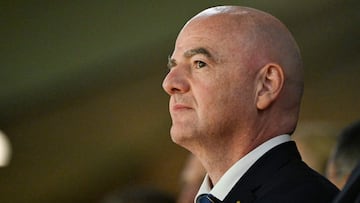2023 WOMEN WORLD CUP
Gianni Infantino tells women they “have the power to change” the narrative for equality
FIFA President encourages women to “keep fighting” for full equality. What is the Women’s World Cup prize money in 2023, and how is different than before?

Fifa president Gianni Infantino says women who “pick the right fights” can “convince us, men, what we have to do” to drive progress in women’s soccer.
During a press conference held before the Women’s World Cup final between England and Spain, Infantino discussed the unequal funding between men’s and women’s World Cup tournaments.
And while the average earnings for soccer players participating in the 2023 Women’s World Cup have gone up from less than eight cents for every dollar earned by their male counterparts in the previous year’s World Cup to approximately 25 cents, as per FIFA, a significant disparity in prize money persists between the men’s and women’s tournaments.
What is the prize money for the 2023 Women’s World Cup?
The current record prize fund of $110 million for this World Cup falls notably short of the $440 million awarded to teams at the men’s finals held last year in Qatar, which drew an audience of 3.4 million fans.
“With men, with Fifa, you will find open doors. Just push the doors,” said Infantino.
“I say to all the women – and you know I have four daughters, so I have a few at home – I say to all the women that you have the power to change,” said Infantino. “Pick the right battles, pick the right fights. You have the power to change.”
Related: The first time three African countries have reached World Cup knockout stage
FIFA’s commitments to close the gap
In June, FIFA announced that a portion of the historic $110 million prize pool for the Women’s World Cup, specifically around $49 million, will be directly distributed to individual players. This ensures that each participating player receives a minimum of $30,000, while members of the winning team will receive $270,000.
The remaining funds will be divided among the participating national federations, which will determine how to distribute this portion among their teams and players, should they choose to do so. Alongside the prize money, FIFA has also committed to providing $42 million to the federations and the clubs of players to aid in preparations for the Women’s World Cup.
Infantil: “We are going in that direction already”
Infantino characterized the concept of equal pay within the Women’s World Cup as a recurring “slogan.”
“Equal pay in the World Cup – we are going in that direction already,” added Infantino. “But, that would not solve anything. It might be a symbol but it will not solve anything because [a World Cup is held for] one month every four years, and it’s a few players out of the thousands and thousands of players [that take part].”
Related: The Barbra Banda story: the broader problem of gender verification in sports
But is that what is happening worldwide?
Last year, the United States Soccer Federation (USSF), the United States Women’s National Team Players Association (USWNTPA), and the United States National Soccer Team Players Association (USNSTPA) reached an agreement that established “equal pay” and a new global precedent in international soccer.
As part of these agreements, US Soccer will become “the first Federation in the world to equalize FIFA World Cup prize money” awarded to the teams participating in World Cups.
However, a report published by FIFPRO in June revealed that out of the players surveyed, two-thirds indicated that they had to take unpaid leave from their other employment in order to participate in World Cup qualifying tournaments for their national teams. These tournaments include events like the CONCACAF W Championship and the Women’s Africa Cup of Nations.
Additionally, nearly one-third of the surveyed players received no payment from their national teams over the past 18 months. Among those who did receive payment, it was frequently contingent on their level of participation and performance, leading to a sense of instability.
Related: Zambia’s inapt conditions, but incredible story
Infantino justified FIFA’s commitment to women’s football by emphasizing the expansion of this year’s World Cup to a 32-team format as a notable achievement in fostering the sport’s development.
The FIFA president also called the 2023 Women’s World Cup “simply the best and greatest and biggest Women’s World Cup ever,” underscoring how this event enabled FIFA to break even due to its substantial revenue prospects.
“Actually, this World Cup generated over $570 million US. In revenues. And so, we broke even. We didn’t lose any money, and we generated the second-highest income of any sport, of course, besides the Men’s World Cup at global stage. More than half a billion. There are not many competitions, even in men’s football, that generate more than half a billion.”






